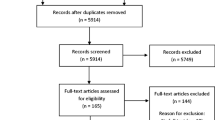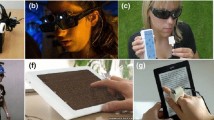Abstract
Purpose
Surgical navigation is typically shown on a computer display that is distant from the patient, making it difficult for the surgeon to watch the patient while performing a guided task. We investigate whether a light-weight, untracked, wearable display (such as Google Glass, which has the same size and weight as corrective glasses) can improve attentiveness to the surgical field in a simulated surgical task.
Methods
Three displays were tested: a computer monitor; a peripheral display above the eye; and a through-the-lens display in front of the eye. Twelve subjects performed a task to position and orient a tracked tool on a plastic femur. Both wearable displays were tested on the dominant and non-dominant eyes of each subject. Attentiveness during the task was measured by the time taken to respond to randomly illuminated LEDs on the femur.
Results
Attentiveness was improved with the wearable displays at the cost of a decrease in accuracy. The through-the-lens display performed better than the peripheral display. The peripheral display performed better when on the dominant eye, while the through-the-lens display performed better when on the non-dominant eye.
Conclusions
Attentiveness to the surgical field can be improved with the use of a light-weight, untracked, wearable display. A through-the-lens display performs better than a peripheral display, and both perform better than a computer monitor. Eye dominance should be considered when positioning the display.




Similar content being viewed by others
References
Beuchat A, Taub S, Saby JD, Dierick V, Codeluppi G, Corno AF, von Segesser LK (2005) Cybertools improve reaction time in open heart surgery. Eur J Cardiothorac Surg 27:266–269
Dixon B, Daly M, Chan H, Vescan A, Witterick I, Irish J (2013) Surgeons blinded by enhanced navigation: the effect of augmented reality on attention. Surg Endosc 27:454–461
Hanna GB, Shimi SM, Cuschieri A (1998) Task performance in endoscopic surgery is influenced by location of the image display. Ann Surg 227(4):481–484
Hart SG, Staveland LE (1988) Development of NASA-TLX (Task Load Index): results of empirical and theoretical research. In: Hancock PA, Meshkati N (eds) Human mental workload. North Holland Press, Amsterdam
Horrey WJ, Wickens CD, Alexander AL (2003) The effects of head-up display clutter and in-vehicle display separation on concurrent driving performance. In: Proceedings of the human factors and ergonomics society 47th annual meeting
Ima C, Mann, D (2003) Lightbar design: the effect of light color, lightbar size and auxiliary indicators on tracking and monitoring performance. Agric Eng Int CIGR E-J Sci Res Dev 3. http://www.cigrjournal.org/index.php/Ejounral/article/view/388
Karatekin JW, Couperus C, Marcus DJ (2004) Attention allocation in the dual-task paradigm as measured through behavioral and psychophysiological responses. Psychophysiology 41(2):175–185
Liu D, Jenkins SA, Sanderson PM (2009) Clinical implementation of a head-mounted display of patient vital signs. In: International symposium on wearable computers, pp 47–54
Liu D, Jenkins SA, Sanderson PM, Fabian P, Russell WJ (2010) Monitoring with head-mounted displays in general anesthesia: a clinical evaluation in the operating room. Anesth Analg 110(4):1032–1038
Miles WR (1930) Ocular dominance in human adults. J Gen Psychol 3:412–430
Minucci PK, Connors MM (1964) Reaction time under three viewing conditions: binocular, dominant eye, and nondominant eye. J Exp Psychol 67(3):268–275
Ormerod DF, Ross B, Naluai-Cecchini A (2002) Use of a see-through head-worn display of patient monitoring data to enhance anesthesiologists’ response to abnormal clinical events. In: International symposium on wearable computers, pp 131–132
Sadda P, Azimi E, Jallo G, Doswell J, Kazanzides P (2013) Surgical navigation with a head-mounted tracking system and display. Stud Health Technol Inform 184:363–369
Shneor E, Hochstein S (2006) Eye dominance effects in feature search. Vision Res 46(25):4258–4269
Webster JL, Cao CGL (2004) Divided attention in using robotic surgical systems. In: Proceedings of the human factors and ergonomics society 48th annual meeting, pp 1751–1754
Acknowledgments
This research was supported by the Natural Sciences and Engineering Research Council of Canada Grant 121650. We would like to thank the reviewers for their detailed reviews and suggestions, many of which we have incorporated verbatim.
Author information
Authors and Affiliations
Corresponding author
Ethics declarations
Conflict of interest
The authors declare that they have no conflict of interest.
Human and animal rights
All procedures performed in studies involving human participants were in accordance with the ethical standards of the institutional and/or national research committee and with the 1964 Helsinki Declaration and its later amendments or comparable ethical standards.
Informed consent
Informed consent was obtained from all individual participants included in the study.
Rights and permissions
About this article
Cite this article
Stewart, J., Billinghurst, M. A wearable navigation display can improve attentiveness to the surgical field. Int J CARS 11, 1193–1200 (2016). https://doi.org/10.1007/s11548-016-1372-9
Received:
Accepted:
Published:
Issue Date:
DOI: https://doi.org/10.1007/s11548-016-1372-9




